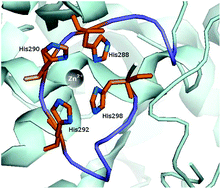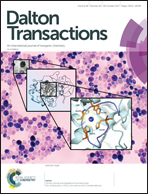Zinc binding sites in Pra1, a zincophore from Candida albicans†
Abstract
The aim of this work is to understand the interactions of Zn(II) with Pra1, a zincophore from Candida albicans, one of the most common causes of serious fungal infections in humans. Pra1 is a 299 amino acid protein, secreted from the fungus to specifically bind Zn(II) and deliver it to a transmembrane zinc transporter, Zrt1. We take the first step towards understanding the bioinorganic chemistry of this process, by pointing out the Zn(II) binding sites in Pra1 and understanding the thermodynamics of such interactions. Our approach involves working on model systems (unstructured parts of proteins) in order to identify those regions in Pra1, to which zinc binds with the highest affinity. Mass spectrometry shows the stoichiometry of Zn(II)–peptide complex formation and potentiometric studies give us the partial and overall stability constants for all the formed zinc complexes. NMR clarifies binding sites in the case of doubts. A detailed comparison of these results shows that the C-terminal region of Pra1 binds Zn(II) with the highest affinity, indicating that this region of the zincophore is responsible for the binding of zinc. Such knowledge is an input to the basic bioinorganic chemistry of zinc; it allows us to understand the inorganic biochemistry of zincophores, and it might be a stepping stone towards finding new, fungus specific treatments based on parts of zincophores coupled with antifungal drugs.



 Please wait while we load your content...
Please wait while we load your content...